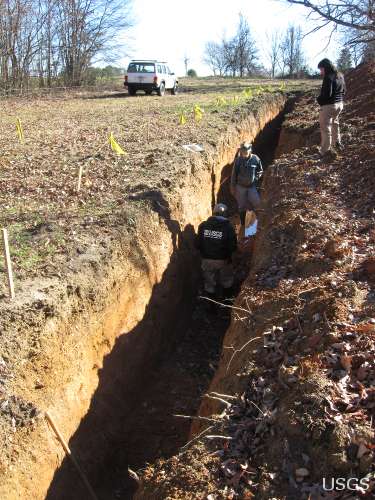23 August 2012
The rare 5.8 Virginia earthquake: One year later
Posted by kramsayer

East Coast earthquakes propagate farther from their sources -- as demonstrated by the map displaying where people reported feeling two different earthquakes. (Credit: USGS)
One year ago today, the Washington Monument – along with many other buildings in Washington, D.C. – shook as a 5.8 magnitude earthquake centered near Mineral, Va., rattled the ground beneath it. Since then, experts have deemed the structure unsafe for tourists to enter and estimated that the monument suffered tens of millions of dollars in damage that will take years to repair. Despite these setbacks, the rare seismic event sparked a new era in earthquake assessment in the eastern U.S.
To commemorate the knowledge gained over the last year and the work still to come, speakers from institutions including Federal Emergency Management Agency (FEMA) and the U.S. Geological Survey (USGS) held a press conference in front of the monument this morning.
The medium-sized earthquake was one of the largest to strike the eastern seaboard in the past 400 years. Scientists suggest it was felt by nearly one-third of the U.S. population – about 100 million people. Due to its size and the rapid response efforts of scientists from the USGS and other institutions, researchers now know more about this earthquake and its aftershocks than any other historical East coast quakes.
“We were able to collect a robust sequence of aftershocks which helped us to capture the perpetrator of this event,” said USGS director Marcia McNutt.
To determine the likelihood and magnitude of another earthquake from a particular fault, the first step is to identify it. In the western U.S., where faults are above ground, scientists have direct access to faults and can more easily identify earthquake origins. Active faults in the eastern U.S., however, can be buried underground, sometimes miles beneath Earth’s surface. This makes it difficult to determine which fault generated the 23 August 2011 quake and how the Earth moved.
But, when the 5.8 magnitude Virginia earthquake struck, scientists quickly deployed seismographs across the eastern U.S., recording more than 450 aftershocks. This data was what helped scientists identify the fault responsible for the main quake.
By doing so, scientists made an important leap forward in making predictions for future tremors originating in the same area, McNutt said.
Moreover, using data from a USGS website called “Did you feel it?” scientists saw how the earthquake’s waves moved out from the fault.
“Nearly 150,000 people recorded their experience on our website,” McNutt said. “Within minutes of the event we knew this earthquake was not propagating in a symmetric pattern.”
Unlike western U.S. earthquakes that spread out in a circular pattern, eastern earthquakes dissipate differently. It’s data like this that will help urban planners prepare for future shocks, she said.
Recently, USGS scientists and others mapped faults and other features deep underground in the eastern U.S. Airborne lidar (shooting lasers from an airplane) will help in looking for earthquake effects by imaging subtle features of the land surface, and data from airborne geophysical surveys will be used to image the Earth from the surface down to where the earthquake occurred 3.5 miles underground. Thanks to the continuing efforts of the scientists, those who responded quickly in the field and the citizen scientists’ reports, researchers have a plethora of data to study well into the next year.
–Jessica Orwig, AGU science writing intern











 GeoSpace is a blog on Earth and space science, managed by AGU’s Public Information staff. The blog features posts by AGU writers and guest contributors on all sorts of relevant science topics, but with a focus on new research and geo and space sciences-related stories that are currently in the news.
GeoSpace is a blog on Earth and space science, managed by AGU’s Public Information staff. The blog features posts by AGU writers and guest contributors on all sorts of relevant science topics, but with a focus on new research and geo and space sciences-related stories that are currently in the news.
could you please explain ?
>>using lasers that can penetrate as deep as 3.5 miles<<
Apologies – we meant lasers (in the form of lidar) and other geophysical surveys (magnetic, gravity, and radiometric). Clarified above. Thanks!
1 Must be scary in the Western US where faults are above ground!!
2 Do western US earthquakes really spread out in a circular pattern? None that I have ever seen.
3 So what was the perpetrator?
* We have used multispectral images of WorldView-2 satellite with 1-2 meter resolution for volumetric 3D GeoSEIS mineral potential mapping (deep: 500-1500m) with much higher resolution (1-2m) than 3D seismic, magneto-telluric, electromagnetic data before drilling : http://www.flickr.com/photos/jeisus2012/7783582120/in/set-72157626153283579/ ;
* We have used multispectral images of Landsat 5-7, ASTER, Hyperion satellites with 15-30 meter resolution for volumetric 3D GeoSEIS mapping of volcano-tectonic structures up to depth 19-60km:
http://www.flickr.com/photos/jeisus2012/5559736588/in/set-72157626153283579 .
VALIDATION CERTIFICATE for “4D GeoSEIS Tomography” Method: http://www.slideshare.net/JarosloveBondarenko/4-d-geoseissertificatrev1 .